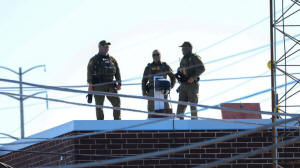Border Patrol Commander Greg Bovino ordered to testify in federal court
[October 27, 2025]
By Hannah Meisel
CHICAGO — U.S. Customs and Border Patrol Commander Gregory Bovino, who
has spent the last 5 ½ weeks running the Trump administration’s
“Operation Midway Blitz” immigration enforcement campaign in the Chicago
area, has been ordered to testify in federal court Tuesday after
allegations he threw tear gas into a crowd Thursday with neither warning
nor justification.
Following news of federal agents deploying tear gas again on Friday,
U.S. District Judge Sara Ellis set an Oct. 28 hearing in an ongoing case
over the Department of Homeland Security’s use of crowd control tactics
on protesters. The judge also ordered lawyers for the Trump
administration to “produce Defendant Gregory Bovino, in person, for this
hearing.”
Ellis had already ordered Bovino be deposed in the case during an Oct.
20 hearing in which the judge expressed concern that DHS officials and
immigration agents alike weren’t following her Oct. 9 temporary
restraining order restricting the use of “riot control” weapons,
including tear gas, on protesters.
The judge questioned a pair of officials from CBP and U.S. Immigration
and Customs Enforcement about recent clashes between federal agents and
members of the public, whose spontaneous protests unfolding against
immigration arrests in their neighborhoods ended in tear gas deployment.
CBP Deputy Incident Commander Kyle Harvick told Ellis that his agents’
use of tear gas in two incidents earlier this month was warranted, as
protesters were impeding on their ability to perform their mission, in
addition to endangering agents. The judge’s order prohibits agents from
using “less-lethal” weapons like tear gas, pepper balls, rubber bullets,
flashbang grenades and tasers on protesters who don’t pose an immediate
threat.

But agents can issue a crowd dispersal order “when three or more persons
are committing acts of disorderly conduct that are likely to cause
substantial harm,” according to the order. In that case, the use of riot
control weapons is permitted if protesters are given at least two
separate warnings loud enough for the crowd to hear and allowing for
“reasonable time and opportunity for individuals to voluntarily comply.”
In a 12-minute video submitted to Ellis on Thursday, Bovino cannot be
heard giving such warnings before tossing a canister of tear gas into a
crowd of protesters hours earlier in Chicago’s Little Village
neighborhood, which is heavily populated by Mexican immigrants.
Immigration agents deployed tear gas again Friday after protesters
surrounded the feds’ rental cars in Chicago’s wealthy Lake View
neighborhood. And on Saturday, agents deployed tear gas in Chicago’s
Irving Park and Avondale neighborhoods.
The Trump administration has claimed the only way to protect immigration
agents from protesters that DHS officials have called “violent” and
“rioters” is by deploying the National Guard. But a federal judge has
blocked troops’ activation in Illinois — at least until the U.S. Supreme
Court weighs in.
Request for release
Bovino has been the face of Operation Midway Blitz since his
mid-September arrival in the Chicago area fresh from running a similar
campaign in Los Angeles. He has made numerous media appearances
defending the Trump administration’s tactics in addition to using his
own social media channels to promote CBP’s capture of undocumented
immigrants with long criminal histories.
But in another Chicago federal courtroom Friday, U.S. District Judge
Jeffrey Cummings heard arguments that the majority of the roughly 3,000
arrests CBP and ICE have made in Chicago and its suburbs in the last
four months don’t have criminal backgrounds. Immigration and civil
rights attorneys told the judge that as many as 2,000 of those are not
subject to mandatory detention and should be released to electronic
monitoring.
The judge questioned Department of Justice attorney William Weiland on
the conditions in which those who’ve been arrested have been held,
including in the ICE processing facility in the Chicago suburb of
Broadview — the scene of many protests in recent weeks. After Weiland
balked that the question of treatment is “beyond the scope” of the
consent decree, Cummings pointed out that the DOJ had included it in its
own filing not long ago.
“Can you certify to me that potential class members who are being
detained are being held in safe and sanitary conditions?” the judge
asked. “Can you certify that as an officer of the court?”

“No, I cannot,” Weiland said before offering to retract that statement
for the record.
Asked whether detainees had “sufficient access to counsel,” Weiland said
he’d have to “have a conversation with my client about that.”
Warrantless arrests, CBP assists
Cummings already ruled earlier this month that ICE had violated a 2022
consent decree that limits immigration agents’ authority to make
warrantless arrests unless they have probable cause to believe a person
is in the country illegally and he or she is a flight risk. Though it
was scheduled to expire in May, plaintiffs’ attorneys had asked for an
extension, which was supposed to have left it in place while the judge
weighed the arguments.
But on June 11, a top ICE lawyer emailed all agency employees advising
the consent decree was dead and officially rescinding the corresponding
agency policy restricting warrantless arrests.
[to top of second column]
|

Three men in Customs and Border Protection uniforms stand on the
roof of a Broadview immigration facility taking pictures of the
surrounding area on Oct. 9. (Capitol News Illinois photo by Andrew
Adams)

As a result, Cummings extended the consent decree until February. In his
ruling earlier this month, the judge wrote that agents’ practice of
carrying blank warrant forms and filling them out at the scene of an
arrest was “explicitly designed” to get around the requirement that
agents have probable cause before arresting an undocumented immigrant.
On Friday, Cummings agreed that the consent decree also applies to CBP,
as DHS describes Operation Midway Blitz as an “ICE operation.”
“CBP is working with ICE,” he said. “So any arrests as part of this
operation I view as arrests working with ICE.”
Policy changes, increased detentions
Between June 11 — the date Cummings determined ICE had officially
violated the consent decree — and Oct. 7 when Cummings issued his order
extending the consent decree, ICE made nearly 1,900 arrests.
And on Friday, Weiland told Cummings CBP has arrested “right around
1,200” people as part of Operation Midway Blitz.
Before a September 5 decision from the U.S. Board of Immigration
Appeals, the vast majority of undocumented immigrants who were arrested
would be released on bond after an immigration judge determined a person
didn’t have a disqualifying criminal record and was not a danger to the
community or a flight risk.
But less than two weeks since Operation Midway Blitz began last month,
the Trump administration’s BIA reversed decades of precedent and ruled
that detention would be mandatory for any undocumented immigrant who
entered the U.S. without being “admitted” by an immigration officer.
A few days later, U.S. Supreme Court Justice Brett Kavanaugh wrote in a
Sept. 8 concurring opinion that although “apparent ethnicity alone
cannot furnish reasonable suspicion” for immigration enforcement
actions, it can be a “relevant factor.” Based on reasonable suspicion,
Kavanaugh wrote that “immigration officers may briefly stop the
individual and inquire about immigration status.”
Those two decisions, combined with ICE’s unilateral decision that the
consent decree was dead, have resulted in far more arrests and
detentions than there otherwise would be under previous policies and
precedents. It’s also meant that those who’ve been swept up in Operation
Midway Blitz have included undocumented immigrants who’ve been in the
U.S. for years or even decades, and who are now being expedited for
deportation.

Attorneys for immigrant and civil rights argued to Cummings on Friday
that the Sept. 5 BIA decision represented a sea change that was
unforeseeable at the time they and the DOJ agreed to the 2022 consent
decree. Despite pushback from the DOJ’s Weiland, the judge seemed to
agree, saying the consent decree would be essentially useless if
“everyone who was arrested and subject to detention proceedings would be
detained as a mandatory matter.”
“What good would this agreement be?” Cummings asked. “Why would they
agree to do something that had no effect?”
The judge also pointed out more than 100 of his colleagues across the
country have rejected DHS’ arguments on mandatory detention since the
agency began testing the new legal theory in July.
Faster deportations
Plaintiffs attorneys argued that because the Trump administration had
committed “repeat material violations” of the consent decree and because
last month’s BIA decision altered the playing field, Cummings had the
authority to order the release of many detainees to electronic
monitoring.
DOJ attorneys accused opposing counsel of painting with too broad a
brush and the judge said he wasn’t comfortable with issuing a blanket
ruling, as “it could be that some of these individuals should not be
released and are properly subject to mandatory detention.”
But Cummings did order DHS to file briefs on the feasibility of handing
over the names, arrest dates, country of origin and “A numbers” for all
detainees. That information will help determine who among the 3,000
would be eligible for release on bond under DHS’ long-running policies —
at least those who haven’t yet been deported.
Mark Fleming of the Chicago-based National Immigrant Justice Center told
Cummings that time is not on the side of detainees, as many have been
pressured to sign voluntarily deportation agreements or have otherwise
had their removal proceedings fast-tracked. He cited the case of an
undocumented immigrant arrested in Elgin as part of a pre-dawn raid that
kicked off Operation Midway Blitz last month. The man had previously
suffered a massive stroke that left his communication abilities
impaired.
“He cannot speak but apparently can consent to voluntary departure to
Mexico,” Fleming said. “We had to scramble to make sure there was
someone to care for him.”
Capitol News Illinois is
a nonprofit, nonpartisan news service that distributes state government
coverage to hundreds of news outlets statewide. It is funded primarily
by the Illinois Press Foundation and the Robert R. McCormick Foundation. |